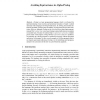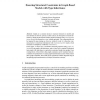3020 search results - page 5 / 604 » Type Analysis of Prolog Using Type Graphs |
ICFP
2004
ACM
14 years 7 months ago
2004
ACM
Useful type inference must be faster than normalization. Otherwise, you could check safety conditions by running the program. We analyze the relationship between bounds on normali...
CORR
2007
Springer
13 years 7 months ago
2007
Springer
Prolog is an excellent tool for representing and manipulating data written in formal languages as well as natural language. Its safe semantics and automatic memory management make...
TLCA
2005
Springer
14 years 1 months ago
2005
Springer
αProlog is a logic programming language which is well-suited for rapid prototyping of type systems and operational semantics of typed λ-calculi and many other languages involving...
FASE
2005
Springer
14 years 1 months ago
2005
Springer
Graphs are a common means to represent structures in models and meta-models of software systems. In this context, the description of model domains by classifying the domain entitie...
PKDD
2009
Springer
14 years 2 months ago
2009
Springer
We propose a new, recursive model to generate realistic graphs, evolving over time. Our model has the following properties: it is (a) flexible, capable of generating the cross pro...


